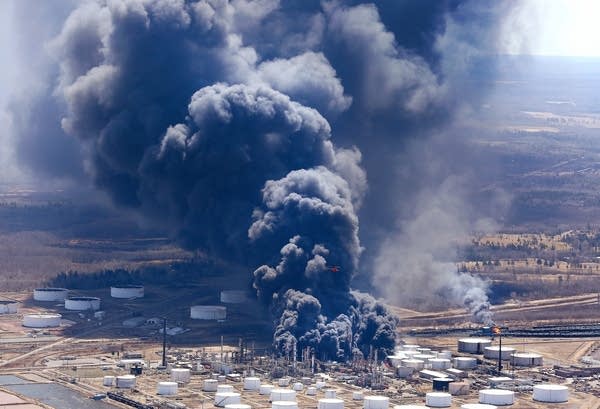Superior residents ask feds to end use of toxic chemical at refinery

Go Deeper.
Create an account or log in to save stories.
Like this?
Thanks for liking this story! We have added it to a list of your favorite stories.
Federal officials heard an earful Wednesday at a public meeting in Superior, Wis., about the explosion and fire at the nearby Husky Energy refinery that injured 36 people and forced the evacuation of much of the city last spring.
About two dozen residents from Duluth, Superior and surrounding areas addressed the three sitting members of the U.S. Chemical Safety and Hazard Investigation Board, who had come to town at the request of several Minnesota and Wisconsin congresspeople.
The April explosion occurred about 150 feet from a spot on the refinery grounds where 15,000 pounds of the chemical was stored. Shrapnel from the blast punctured a nearby tank of asphalt, which gushed out and caused a massive fire to burn for about four hours, creating an enormous black smoke plume.
But debris from the explosion did not damage the tank containing the hydrogen fluoride, and a fire suppression system kept the tank protected.
Turn Up Your Support
MPR News helps you turn down the noise and build shared understanding. Turn up your support for this public resource and keep trusted journalism accessible to all.
Still, Norm Herron of Duluth told board members that Husky should replace the chemical with something less hazardous.
"The cost to manufacture a product must never take precedence over the safety and health of the people who reside and work in the Twin Ports," he said.
The Chemical Safety Board, as the federal agency is more generally known, investigates major chemical accidents nationwide. The independent board delivers recommendations, but it can't issue fines or citations.
The explosion and fire at the Husky refinery was caused by a failed valve that allowed air to mix with hydrocarbons in a part of the refinery where crude oil is processed into gasoline and other byproducts.
CSB investigator Mark Wingard offered an update on the agency's investigation at the start of the meeting. He said the cause of the incident was very similar to that of an explosion at an ExxonMobil refinery in Torrance, Calif., in 2015.
Both incidents also took place at a moment when the refineries were nearing the end of an operating cycle. The Superior refinery was in the process of shutting down for maintenance after running since 2013.
Both explosions also occurred near tanks containing hydrogen fluoride. In the CSB's final report on the Torrance incident, the agency called it a "near-miss event" in which explosion debris nearly hit tanks containing the toxic chemical.
The federal government subsequently sued ExxonMobil to force the company to release additional information related to the incident and to safety measures in place.
Chemical Safety Board member Rick Engler told the crowd in Superior that it makes sense to investigate whether debris from the explosion at the Husky refinery could have hit vessels containing hydrogen fluoride.
"I feel strongly that there have been enough incidents over history, there's enough consensus among many, that hydrogen fluoride poses a potentially severe risk to communities. And the CSB needs to take very seriously some type of action steps to move that forward," he said.
Husky Energy spokesperson Mel Duvall said in an email that the company realizes "the community still has questions and concerns about what happened on April 26, as well as what the rebuild of the refinery will look like."
Husky doesn't expect to resume operations until sometime in 2020, and Duvall said the company is still evaluating options around the use of hydrogen fluoride.
The Chemical Safety Board plans to release its final report with recommendations sometime next year.
Dear reader,
Political debates with family or friends can get heated. But what if there was a way to handle them better?
You can learn how to have civil political conversations with our new e-book!
Download our free e-book, Talking Sense: Have Hard Political Conversations, Better, and learn how to talk without the tension.




